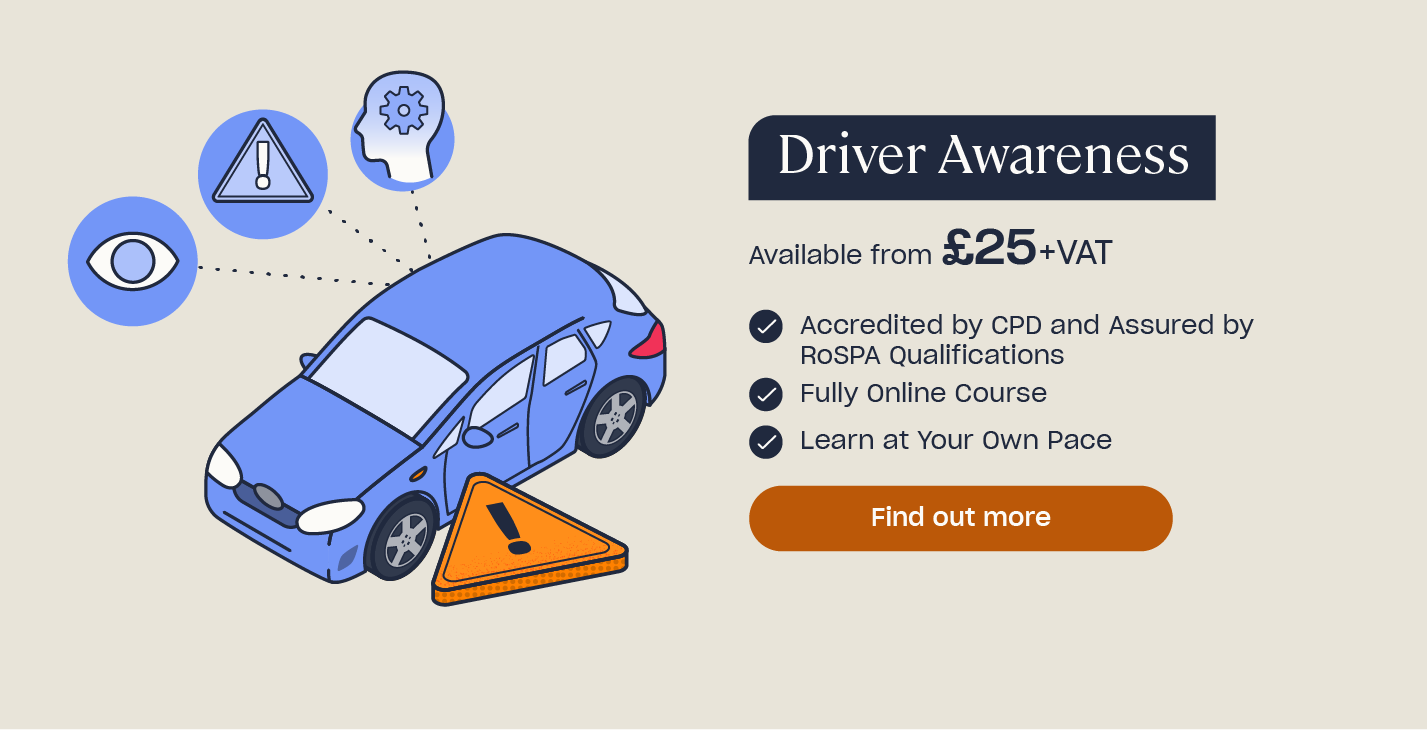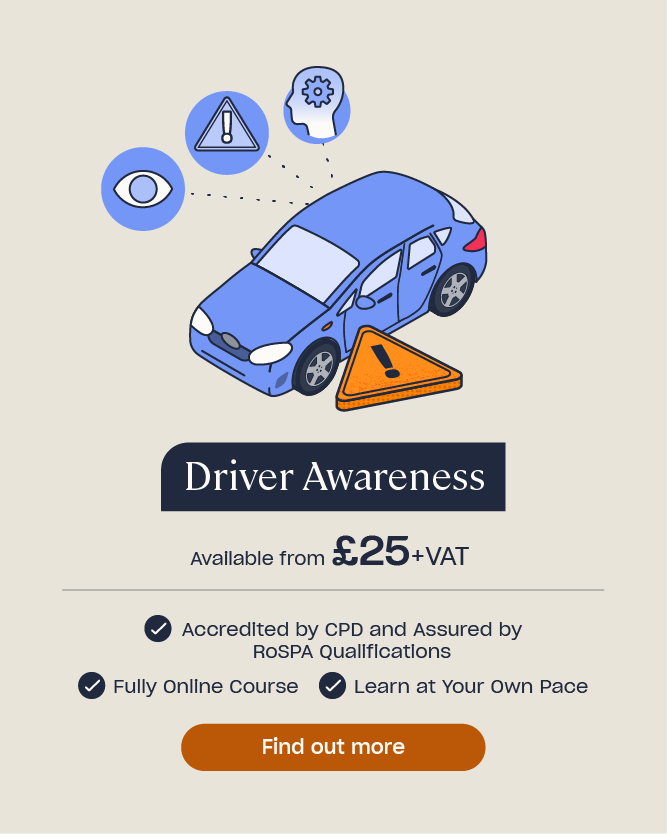Driving Safety Tips for Employees
Many people are required to drive as part of their role at work, and this can present a number of risks. According to the HSE, approximately up to a third of all road traffic accidents involve someone who is at work at the time, which may account for over 20 fatalities and 250 serious injuries every week. It is therefore essential that both employers and employees work together to reduce the risks involved to help ensure safety.
In this article, we will outline some of the risks associated with driving at work and provide a range of driving safety tips to help keep you and others safe while you’re driving.
What are the Risks of Driving for Work?
Driving is a common – and for some, an essential – part of life. However, as convenient as driving can be, it also comes with risks. These risks can be amplified when you drive for work, for a number of reasons.
The Royal Society for the Prevention of Accidents (RoSPA) state in their Safer Driving for Work handbook that people who drive for work ‘crash more often, even after their higher mileages are taken into account and are more likely to take risks and to be at fault when they crash.’
This isn’t to say that drivers who drive for work are any less skilled or even intentionally more reckless than people who drive for leisure. It just means that people who drive for work are generally exposed to more risks than the average driver, many of which are difficult to avoid. For example, at-work drivers may be required to drive in more dangerous conditions, such as during extreme weather, or while under pressure to complete a job within a time limit.
Health and safety law applies to work activities on the road in the same way as it does to all
work activities and you need to manage the risks to drivers as part of your health and safety
arrangements.
Health and Safety Executive ‘Driving at Work’ Guidelines for Employers.
Legally, employers have a duty to ensure that their drivers are properly trained and competent to drive safely at work. However, they also have a responsibility to protect the safety of their employees as far as is reasonably practicable. This means having systems in place to ensure the vehicle they supply is monitored, safe for use and suitable for its intended purpose. This includes making sure that the vehicle is properly taxed, MOT’d and serviced. Employers are also required to investigate and action any accidents or incidents that occur involving their drivers on the road in order to mitigate future risks and help to keep their employees safe.
Employees also have a responsibility to protect their own safety, and the safety of others while driving for work – including pedestrians, other drivers and anyone else they might come across . This involves making sure that they understand and follow not only their workplace’s policies and procedures for health and safety while driving but also the road traffic laws.

9 Driving Safety Tips for Employees
Below are some tips to keep in mind if you drive for work that can help you to not only comply with health and safety law but keep yourself and others safe on the road.
1. Ensure you’re legally fit to drive
The first thing to consider if you’re required to drive for work is whether you are legally fit to do so. This means asking yourself:
- Do you have an up-to-date driving licence?
- Are you insured to drive the vehicle you’ll be using?
- Has your vehicle (whether this is your own or a company-owned vehicle) been properly serviced, MOT’d and insured? Though it is your employer’s responsibility to make sure that the vehicle is safe, you may be required to make the appointment to service the vehicle, for example, yourself.
- Do you feel confident and safe behind the wheel?
- Do you have any medical conditions that would prevent you from driving safely? For example, if you are required to wear glasses to drive, is your prescription up-to-date and valid? Legally, you must be able to read a vehicle number plate clearly from twenty metres (approximately five car lengths) away.
- Have you consumed anything that would prevent you from driving safely? For example, if you have consumed alcohol or drugs (both illegal or prescription), you would be considered unfit to drive and doing so while under the influence of substances could lead to legal consequences including fines, driving bans or even prison sentences.
- Are you aware of your company’s policies and procedures regarding driving safely at work?
You can find more information about assessing your fitness to drive on the government website, here.
2. Conduct a pre-drive vehicle check
While your employer is required to provide you with a safe and suitable vehicle, as an employee, you have a responsibility to conduct a check of your vehicle before you drive, too. This can help make sure your vehicle won’t break down on the road and pose a danger to you and others.
This includes checking:
- There are no signs of damage that could affect your ability to drive the vehicle safely, including to the windscreen or windows.
- The tyres are in good condition, are at the correct pressure and meet the legal tread depth.
- There is sufficient oil, water and windscreen fluid available.
- Essential parts of the vehicle are in good condition and work effectively such as the brakes, lights, indicators, washers and wipers.
You may find it useful to create a driving to work checklist to help make sure nothing is forgotten or overlooked when it comes to conducting a pre-drive check.

3. Plan your journey
It’s essential that you sufficiently plan your journey before you begin driving. Before setting off, you should consider:
- Are you familiar with the vehicle you are going to drive?
- Have you conducted a pre-drive vehicle check?
- Are you aware of, or familiar with, the route you are going to take?
- Do you know the types of roads you will be driving on and the rules for each of these? For example, your journey may include motorways, roundabouts, rural or urban roads.
- Do you know how long the journey should take?
- Will the journey involve driving in busy traffic or during rush hours?
- Does the journey involve driving at night?
This also includes considering if you have the confidence and experience as a driver to complete the drive safely, meaning you can make fast and assured decisions on the road. This could mean the difference between safely navigating a hazard and being involved in an incident because you were hesitant in your decision.
Effective planning can be the difference between a safe and successful journey and an accident occurring. By planning out your route beforehand, you can prepare yourself accordingly for the route you will take and this will put you in a much better position to mitigate the risks involved.
You can find RoSPA’s ‘Safer Journey Planner’ if you need further guidance.
4. Check the weather
As part of planning your journey, you should be sure to check the weather forecast before you leave as this can affect your ability to drive safely and add to the risks you will face.
Once you are aware of the weather forecast, you can then judge if it’ll be safe for you to drive in the expected weather conditions. If the conditions expected during your journey are very poor, you need to think about whether it’s essential to make the journey or if you could wait until the weather improves.
If you decide that the expected conditions are too risky, you must let your employer know. No one can make you drive in dangerous conditions – even if you are driving for work. Instead, your employer should support you and your decision if you decide that the weather will impact your ability to keep yourself and others safe.

5. Comply with the Highway Code and Road Traffic Laws
Another part of planning your journey is making sure you’re up to speed with the Highway Code and its guidance on how to protect other road users when you drive. The Highway Code aims to promote safety on the road for all of its users, whilst also supporting a healthy, sustainable and efficient transport system.
As a driver of a car or van, you’re responsible for protecting other road users on your journey – especially those who are more vulnerable than you. This means adhering to, and applying at all times, the Highway Code and Road Traffic Laws while you’re driving.
These rules include, but are not limited to:
- Only overtaking vehicles when it is safe and legal to do so.
- Staying within the designated speed limit.
- Taking care at junctions and giving way correctly to other vehicles, pedestrians, cyclists and horse riders.
- Keeping your vehicle within the designated driving areas – for example, not crossing over a white line into another lane, encroaching a cycle lane or a road crossing when it’s in use.
- Adhering to ‘STOP’ signs and traffic lights.
- Wearing your seatbelt at all times.
- Refraining from using your mobile phone while driving.
You can purchase a copy of The Highway Code at any online retailer and in some high street shops.
6. Avoid distractions
It’s vital to remain focused on the road while you’re driving; however, distractions are common, sometimes unavoidable, and can easily cause accidents. Anything that takes your attention away or interrupts your concentration is dangerous and so it is essential that you not only recognise what can distract you, but know how to avoid these distractions so that you can remain focused and safe while driving.
Distractions can be categorised into four main groups: visual, auditory, manual and cognitive.
- Visual: This is everything you can see, both inside and outside of your vehicle. For example, pedestrians at the side of the road or a particularly impressive landscape outside may catch your eye, or your GPS system/sat nav may catch your attention.
- Auditory: This is everything you can hear, both inside and outside of your vehicle. For example, loud or sudden noises outside, such as music playing from a house or another vehicle, other passengers or approaching emergency vehicles. Some auditory distractions can’t be avoided and could even alert you to hazards, such as sirens from emergency vehicles. If you’re struggling to concentrate because of noise, however, then turn your music down or off and ask any passengers to be quiet. If you’re worried about a sound from your car, stop somewhere safe before you check it out.
- Manual: This is anything that requires you to take your hands off the wheel while driving. For example, you may be tempted to eat while you’re driving, interact with your GPS or sat nav or change the radio station. If you need to interact with something, then always stop somewhere safe like a service station, carpark or layby before doing so.
- Cognitive: This is anything you are feeling or thinking about which could distract you from driving safely. For example, if you haven’t had a good night’s sleep, you may find your mind wandering and unable to focus, or if you have passengers in the vehicle, your attention may be on conversing with them rather than on the road in front of you. To avoid cognitive distractions, you shouldn’t drive at all if you’re feeling anything other than calm, collected and alert. Stop the car somewhere safe and take a break to gather your thoughts and clear your mind before setting off again.
All of these distractions can affect your ability to drive safely. While some of them can’t be avoided – for example, you can’t control the noise that others make outside of your vehicle – it’s important that you remain concentrated and vigilant in order to keep yourself and others safe while driving.

7. Make sure to take regular breaks
Rest breaks at work are vital for both our physical and mental wellbeing. The human body can’t stay in a static position for prolonged periods, nor can the mind focus continuously. This is especially relevant while driving.
Taking regular breaks can help to alleviate your risk of developing a musculoskeletal disorder (MSD), which is any injury, damage or disorder of the joints or tissues in the upper or lower limbs, neck or back that can cause discomfort and pain, such as repetitive strain injuries (RSIs). They are especially common in employees who drive heavy vehicles, drive long distances or drive over rough terrain.
You can find out more about MSDs and how to manage the risks they pose at the Health and Safety Executive’s (HSE) website, here.
Regular rest breaks also give your mind time to relax and refocus before driving again. We have already established how distractions can cause accidents, and it takes continual concentration to be able to drive safely. Giving your mind a rest from being in a state of constant concentration and focus is thoroughly important in keeping yourself and others safe while you’re driving.
As part of your journey planning, you should factor in regular breaks when figuring out how long your journey should take. You should also make the time to identify safe places that you can stop for a break. Consider where the service stations, towns or car parks are on your route if you’re making a longer journey.
8. Communicate with your manager
If you have any concerns about the condition of your vehicle, the route you’re required to drive, your own competence or confidence behind the wheel or anything else that can affect your ability to drive safely, you must communicate this with your manager.
Your safety, and the safety of others while you’re driving, is of the utmost importance and your employer is required by law to do everything practicable to maintain this.

9. Complete Driver Awareness training
One way to increase your confidence and ensure you’re aware of your own responsibilities as an employee (and that of your employer) when driving for work is to take driver awareness training.
This can help you to recognise the risks associated with driving and provides tips and techniques for minimising them. Driver awareness training covers how to plan for a safe journey and how to conduct pre-drive safety checks. It also includes what to do in the event of a breakdown or emergency situation and information on managing hazards and distractions on the road.
We hope you’ve enjoyed this article on driving safely at work and that you’ve found the tips and advice useful. If you have any further questions or wish to find out more information on the topics covered in this article, call a member of our friendly support team on 0333 006 7000.
Further Resources
- Driver Awareness Course
- RIDDOR: How to Report an Incident or Accident at Work
- Toolbox Talks in Construction: Guidance on Meeting Topics and Resources







